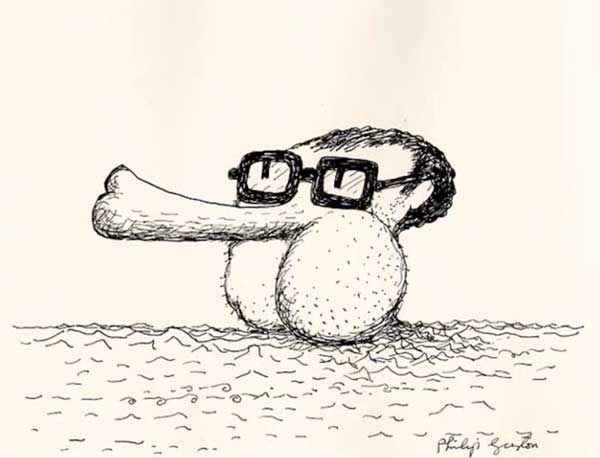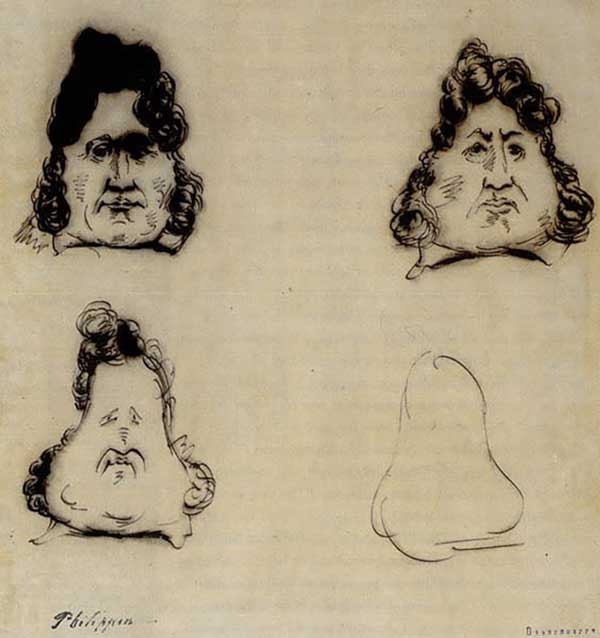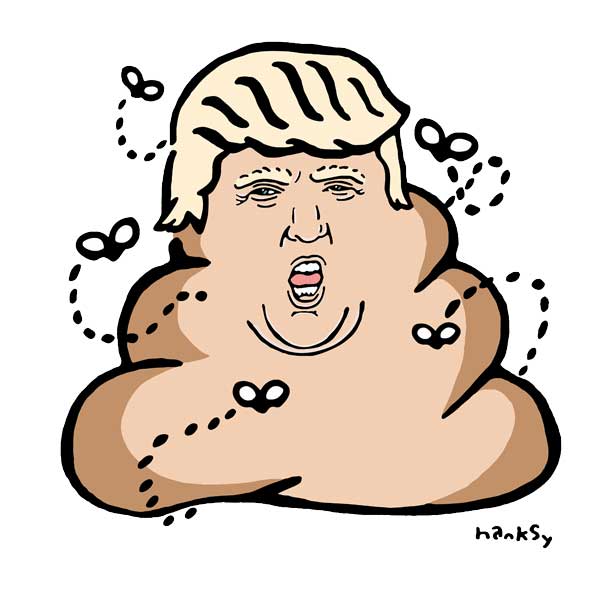Taking A Trump: Political Caricature That Keeps You Regular
by Tucker Neel
Artillery Magazine Jan / Feb 2017
It’s worth considering why it’s so easy to caricature Donald Trump. He looks strange—with his fake tan, anus-like pout, signature comb-over—topped with a bright red, race-baiting ball cap. Like any President-to-be, he’s the focus of boundless criticism and ridicule, yet pundits and partisans have marveled at his ability to refract most critiques in a way that makes him even more omnipresent and influential. In fact, Trump WANTS to be caricatured. He uses the confounding illogic of his comic persona like no other politician. Don’t be fooled, he may personally not like some of his public ridicule, but he uses imitation as flattery in service of obfuscation. It would be naive to think that Trump’s late-night Twitter rants against portrayals of him are the whines of a bruised ego rather than a calculated (and often successful) attempt to focus the next day’s news cycle on him and his message. Any satire relying on a recognizable depiction of Trump, particularly centered on an image of his body, seems to only augment his symbolic power, feeding the troll and contributing to his cult of personality. So, in an age of Trump, when the force of satire is inverted, judo-like, away from political critique and towards calculated distraction, it’s vital that all concerned parties, especially engaged artists, reconsider the use and deployment of political caricature and the ways it must re-define terms of engagement. Caricature can work, but how will it work now?
 Yuge: Thirty Years Doonesbury on Trump book cover by Garry Doonesbury, 2016
Yuge: Thirty Years Doonesbury on Trump book cover by Garry Doonesbury, 2016Political cartoons can be prescient. Take Garry Trudeau’s Doonesbury for example. The Pulitzer Prize–winner predicted a Trump presidency 29 years ago. A look through Yuge, Trudeau’s recently published collection of Trump strips, charts the rise of the megalomaniac leader with eerie accuracy, predicting his political maneuvers from candidacy announcement to sexual scandals. However, Doonesbury, despite its anti-establishment, comic reporting, doesn’t seem to be the best way way to challenge a Trump presidency because the 45th President elect has proven able to exploit America’s critical laziness and distrust of facts to evade accusations and demands for answers and accountability. Perhaps we need something less literal, more pictorially simple, metaphorical and “artistic.”
 Untitled (Poor Richard), 1971, Ink on paper, © The Estate of Philip Guston, Courtesy Hauser & Wirth
Untitled (Poor Richard), 1971, Ink on paper, © The Estate of Philip Guston, Courtesy Hauser & Wirth Untitled (Poor Richard), 1971, Ink on paper, © The Estate of Philip Guston, Courtesy Hauser & Wirth
Untitled (Poor Richard), 1971, Ink on paper, © The Estate of Philip Guston, Courtesy Hauser & WirthThis sort of approach is best seen in Philip Guston’s stylized depictions of Richard Nixon. Made over the course of a few months in 1971, Guston’s “Poor Richard” series is an iconographic interpretation of Tricky Dick, showing him as a fumbling Klan-robe triangle, or lumbering testicles, or gesticulating phallus, all rendered in the artist’s jittery line. These drawings didn’t actually impact Nixon or his administration; they pretty much stayed in the insular world of “fine art.” However, they do offer one approach to undermining Trumpian symbolic slipperiness. By wedding Nixon to an image of a faulty phallus, Guston stumbled on a semiotic goldmine. It takes hundreds of drawings to do so (as repetition is instrumental in solidifying semantic meaning), but Poor Richard turns Nixon into a symbolic limp dick—and the connection sticks!
King Louis-Philippe of France was a bad leader and he didn’t take kindly to caricature. We know this because he responded to scathing images of him and his family with calls for tightened censorship laws, trials for artists and editors, and seizure of printed publications. One popular weekly, La Caricature, edited by Charles Philipon, responded to the king’s conservative crackdown in an ingenious way that we can certainly learn from today.
 Charles Philipon, La Métamorphose du roi Louis-Philippe en poire, Department of Prints and Photographs, B 16, Rés. Philipon, Bibliothèque Nationale de France, (The Metamorphosis of King Louis-Philippe into a Pear) Pen-and-bister-ink drawing, c.1831
Charles Philipon, La Métamorphose du roi Louis-Philippe en poire, Department of Prints and Photographs, B 16, Rés. Philipon, Bibliothèque Nationale de France, (The Metamorphosis of King Louis-Philippe into a Pear) Pen-and-bister-ink drawing, c.1831When accused of insulting the body of the king with a political cartoon in 1831, Philipon argued that it was impossible to prove his publication’s images were in fact of the actual king since they carried no written text delineating this connection. Instead, he championed the power of the drawing as a container for meaning. To prove his point, Philipon sketched four images of the king’s head morphing into a pear, stating that anything could be a picture of royalty. What wasn’t lost on anyone in the courtroom was the word “pear” in French is slang for “idiot.” Shortly after his trial, Philipon’s courtroom drawing appeared in La Caricature and was distributed to a vast readership. Eventually Philipon was arrested, tried and served a year in jail. But the damage was done; the King was forever transformed in the public imagination. The more the royal family went after anyone who rendered their likeness in pear-form, the more this association solidified. As hostilities grew, the French underclass used the pear as a sign of resistance, scribbling it on poor neighborhood walls and prison cells. Caricature can indeed be a semiotic weapon when deployed with consistency to a willing audience. So, if anything can be the King, how are we going to re-brand King Trump?
 Hanksy, Dump Across America, © 2016 by DumpAcrossAmerica.com.
Hanksy, Dump Across America, © 2016 by DumpAcrossAmerica.com.Trump caricatures abound, from body-shaming sculptures to Alec Baldwin’s SNL doppelgänger (Trump butt plugs and club-able piñatas too!). But my favorite is the artist Hanksy’s Dump Trump poop icon. It’s a simple image that takes the smiling poop emoji and turns it into a screaming Trump, with a few buzzing flies signaling the turd has overstayed its welcome. Download it for free at dumpacrossamerica.com. Given the ubiquity of emojis as a valid form of communication, I wonder if it’s possible to insert this simple icon into everyday language. The process would certainly require circumstantial factors similar to the Philipon pear, but in the age of social media it seems totally possible that concerned, motivated parties can begin to replace “Trump” with [insert icon here] and by extension his entire administration and all it entails. Dispensing with the poetics of pears and cutting to the shit, President Trump becomes [insert icon here] . This collective effort won’t make [insert icon here] or the destructive ideology he enacts disappear, but it will tie his name, the thing he values most, to a universally repellent object. This, I think, is a caricature [insert icon here] can’t absorb; shit is just too repulsive. Eventually, we wont need [insert icon here] ’s face on the feces and all shit will be synonymous with his name. So, please let this be a rallying call to post the poop as one of many points of resistance [insert icon here] won’t be able to avoid in the dark days to come.
©2024 Tucker Neel. All rights reserved.